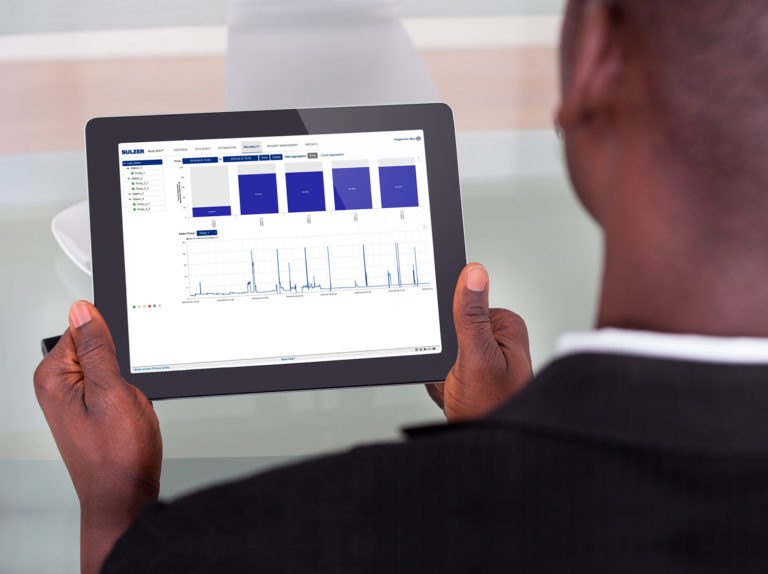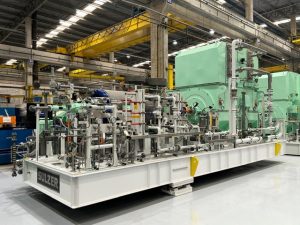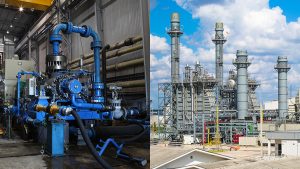Machine Learning Is Not Enough: Advanced Analytics Program for Pumping Systems

Machine learning and expert analysis eliminates false positives ensuring accurate predictions of performance (Image source: Sulzer Ltd.)
Building a more robust and flexible solution that can validate real-world anomalies and adapt to changing IT policies requires an end-to-end approach that combines technology knowhow, equipment expertise, and operating experience.
Dr. Marc Heggemann and Seth Tate of Sulzer explain why machine learning needs to be augmented to ensure a positive outcome, and how a properly integrated solution should be delivered.
Pumping systems, especially those classified as ‘high-energy’, deliver raw materials, such as oil, gas and water, to processing plants before they are transformed into products that are used in everyday life. Analyzing asset health to optimize operation and maintenance actions provides the competitive advantage in production and transportation and thus the motivation for introducing machine learning.
Measuring success
Advanced analytics solutions that aim to improve business performance can only be deemed successful if they deliver a measurable benefit to safety, the environment or business finances. From the outset, the solution needs to be flexible and end-to-end capable, in order to deliver the business’ objectives.
As such, these digital solutions are a value enabler, giving operations the opportunity to take the best action based on the provided intelligence. Pumping systems can vary greatly by design and cost. Running high-energy pumps, or those with high risk fluids, to the point of failure can easily have implications far greater than USD 100’000 per occurrence.
However, using a digital solution to accurately predict pre-failure conditions of pump system components and then performing remedial actions is far from a simple process. In fact, creating a solution that achieves the corporation’s goals and offers the flexibility to adapt to future changes requires considerable system design expertise and historical equipment knowledge. This is best explained using an actual installation where the operator was searching for an efficient asset management solution.
Case study: setting the criteria
A large solar power installation, operated by a company that has sites in three continents, wanted to further improve their predictive maintenance program while meeting a project rationale and corporate data policies. An advanced analytics solution requires data security based on individual company policies as well as the ability to change and grow over time with these policies.
In this case, the operator was already performing data analysis and anomaly detection with a data science team. Sulzer’s role was to augment their approach and by working closely with them, provide analytics that complement their existing work. Sulzer outlined the capabilities and benefits of BLUE BOX™ and how a collaboration would enable them to achieve their goals.
During onboarding, the process of uploading historical data began to train the machine learning algorithms. Once complete, an open channel for new data points was created and monitoring began. Throughout this process, weekly meetings were held to discuss all the tasks, including data quality, and any potential issues with the pumping system would be highlighted. Interaction between the groups aimed to deliver improved data quality and fewer system issues as well as mutual training gains.
Data checking
As part of the process of receiving information from the data historian, there is a need to perform a data sanity check, which is essentially an audit of their operational data; highlighting any issues that need to be remediated. It takes an understanding of not just the data but also the equipment and application to be capable of doing this.
For example, one of the data points received was motor current. Through equipment expertise and operating experience, it was clear that this was bad data. Further investigation onsite revealed that the data being sent was not amperage, but percentage yield instead; the data tags on the supervisory control and data acquisition (SCADA) system were incorrect.
It is essential that data quality is part of the analysis process, not only during the initial setup, but also continuously throughout the period of the advanced analytics program. In the case of BLUE BOX, it is a continuous task every time an anomaly is detected. It is crucial that an advanced analytics program never suggests an action based on bad intelligence.
Anomaly detection
Mathematical models learn from historical data to identify similar patterns. However, in this application, pump failures do not occur very often and most operators do not have the history of operation and maintenance readily available in a digitized format. For that reason, Sulzer leverages unsupervised machine learning techniques, where the models are trained with the recent operational history of the pumps together with physical pump modeling.
Returning to the example, not long after the SCADA issue was resolved, BLUE BOX flagged four anomalies on a single pump over a couple of days, where the performance of the asset deviated from the healthy state. The onsite data science team was also running, in the background, its own algorithms and further investigation found a similar abnormal event for the same period.
By combining the two independent sets of results, it was possible to validate the information and conclude the presence of a pre-failure condition within the motor. Analysis of the motor power and shaft speed had identified a bearing that was in pre-failure condition, yet far below the alarm limits for vibration and temperature.
Acting on information received
Without an in-depth understanding of pumping systems and the lack of any other alarms, some operators may choose not to follow the decision support delivered from a predictive maintenance system. The benefits of these systems are only achieved if the operator trusts the information being delivered.
This is the point, for Sulzer, where the equipment optimization specialists (EOS) come to the fore. Building on BLUE BOX as a common basis for engaging with the operator, these experts address a need for the technical ability and experience to complement the insights – such as on a detected anomaly – offering expert advice to the operator and enabling an action plan to be formulated. Collaboration between site personnel and the EOS allows the options to be defined, along with the required actions, timings and benefits. From here, the information can be delivered to the decision makers, with supporting evidence, to allow them to make a well-informed choice.
A solution turns anomalies into insights and insights into actions. Digital solutions deliver decision support, however, no solution is of value without connecting to action. Ultimately, machine learning on its own has limited benefits, there are several other aspects that need to be combined to deliver an end-to-end solution.
Data quality must have a continuous reality check. It takes an expert understanding of how the physical equipment design is represented in a digital format, to protect from false positives and react to true intelligence.
Data security is paramount, without meeting the corporate security policy, the project will never take off. Any changes to this policy must be accommodated so the analytics solution needs to be flexible.
Sulzer’s BLUE BOX is a good example of how machine learning can be combined with extensive pump knowledge that comes from being an original equipment manufacturer (OEM) to enable actions to be planned, keeping costs to a minimum and avoiding downtime wherever possible.
Source: Sulzer Ltd.







